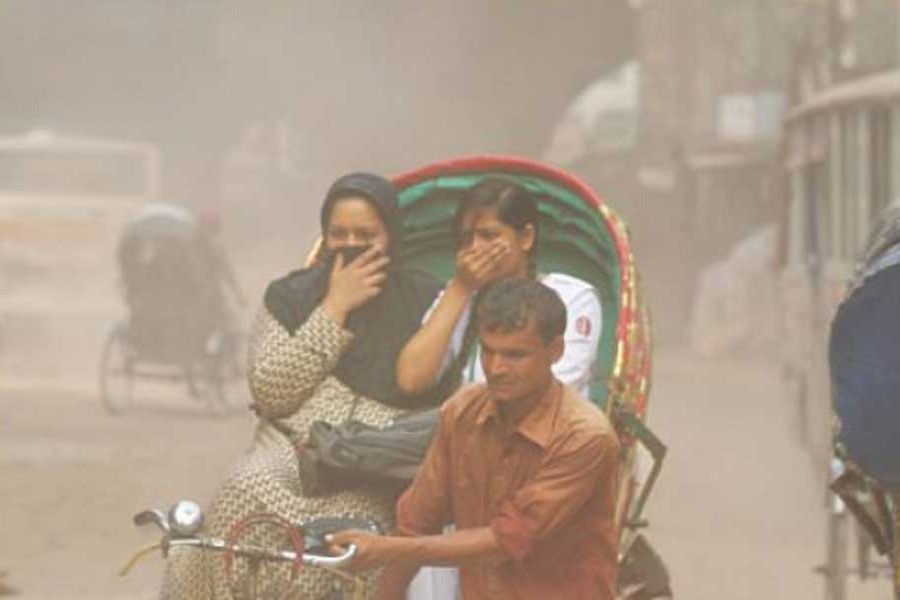Chronic air pollution shortens the average life expectancy of Bangladeshis by 6.9 years, according to a global study that says Bangladesh is the world’s “most polluted country”.
Some areas of Bangladesh fare much worse than average, with air pollution cutting lives short by nearly nine years in Dhaka, the country’s most polluted city, the University of Chicago's Energy Policy Institute said in its latest Air Quality Life Index.
The researchers used satellite data to measure levels of PM2.5, hazardous floating particles that damage the lungs, reports bdnews24.com with details from Reuters.
If global PM2.5 levels were reduced to the five micrograms per cubic metre recommended by the World Health Organization, average life expectancy would rise by an average of 2.2 years, according to the study released on Tuesday.
In no region of the world is the opportunity for improved health and life expectancy greater than in South Asia, which includes four of the five most polluted countries in the world.
In Bangladesh, India, Nepal, and Pakistan, the AQLI data reveal that the average person would live five years longer if pollution were reduced to meet the WHO guideline.
Due to South Asia’s high population and pollution concentrations, the region accounts for 52 per cent of total life years lost globally due to particulate pollution exceeding the WHO guideline.
While India contains the most polluted air in some of its regions, the most polluted country overall in the world is Bangladesh. According to new and revised satellite-derived PM2.5 data, Bangladesh had pollution concentration of 75.8 micrograms per cubic metre in 2020. That’s a 13.1 per cent increase in pollution during a year when Covid-19 lockdowns were in place.
While this is a significant increase over the 2019 level of 67 micrograms per cubic metre, pollution in Bangladesh has remained consistently high over the past decade, fluctuating between 63 and 77 micrograms per cubic metre. That’s 12 to 15 times higher than the WHO guideline.
The researchers do not find the increase in South Asian air pollution over time “surprising”. Over the last two decades, industrialisation, economic development, and population growth have led to skyrocketing energy demand and fossil fuel use across the region. In India and Pakistan, the number of vehicles on the road has increased about four-fold since the early 2000s. In Bangladesh, the number of motor vehicles roughly tripled from 2010 to 2020.
In Bangladesh, India, Nepal, and Pakistan combined, electricity generation from fossil fuels tripled from 1998 to 2017.
Crop burning, brick kilns, and other industrial activities have also contributed to rising particulates in the region.
‘GREATEST THREAT TO HUMAN HEALTH’
Measured in terms of life expectancy, particulate pollution is the greatest threat to human health in Bangladesh, reducing life expectancy by almost seven years on average, the researchers said.
In contrast, child and maternal malnutrition reduces average life expectancy by about 1.4 years in the country, while smoking reduces average life expectancy by 1.6 years.
More than 97 per cent of the global population lives in areas where air pollution exceeds recommended levels, according to the study. In Bangladesh, all of its 16 million people live in areas where the annual average particulate pollution level exceeds both the WHO guideline and the country’s own national standard.
In each of the country’s 64 districts, particulate pollution levels far exceed the WHO guideline.
In Dhaka, the largest city in Bangladesh, air pollution is significantly higher than the national average of 88.9 micrograms per cubic metre, and residents are losing more than eight years of life expectancy on average.
In Chattogram, residents are losing 6.6 years.
Air pollution has been neglected as a public health issue globally, with funding to address the problem still inadequate, the study warned.
"Now that our understanding of pollution's impact has improved, there's a stronger case for governments to prioritise it as an urgent policy issue," said Christa Hasenkopf, director of EPIC's Air Quality Life Index.
As part of its efforts to prevent air pollution, Bangladesh is expanding its monitoring capacity and real-time measurements are expected to soon cover eight cities, up from the four that are covered today, according to the report.
Bangladesh has both encouraged brick kiln owners to shift to cleaner technologies. In Bangladesh, where brick kilns are responsible for about 60 per cent of the particulate pollution in Dhaka, the law governing brick kiln production was amended in 2019 to prohibit the establishment of brick kilns near residential, commercial, agricultural, and environmentally sensitive areas.
In addition, the government is planning to phase out the use of bricks in favour of concrete blocks by 2025 in order to lessen the damage to both the quality of the air and topsoil.
“Ultimately, the success of these policies will be judged by whether particulate pollution actually decreases. We will need to turn to air quality data produced in these countries in the coming years to provide a quantitative assessment,” the report said.


